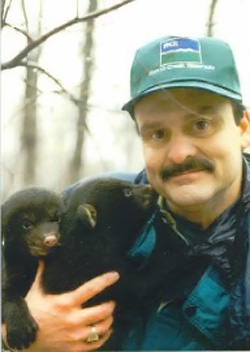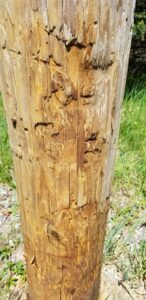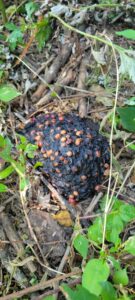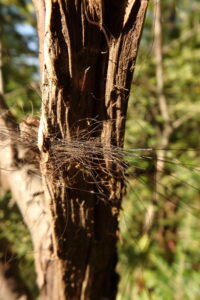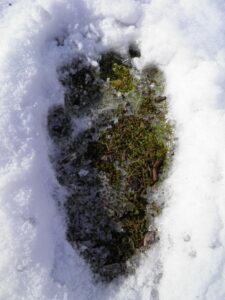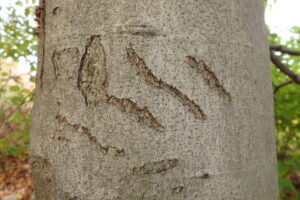MCR Monthly Newsletter
What’s Hatchn’ing at Merrill Creek Reservoir with Ranger Rich

About the Author: Richard Dansen Sr.
Rich has a bachelor’s degree in Environmental Science with a concentration in zoology and wildlife management. Rich has been with Merrill Creek Reservoir since 1995 where he teaches environmental education.
You can find Rich each weekend at the MCR visitors center talking about the wonderful wildlife and habitats of MCR. Stop by to say hi!
“In writing this monthly newsletter, I hope to inform and educate readers about some of the wonderful and fascinating events going on in nature at Merrill Creek Reservoir each month. Enjoy!”
– Ranger Rich
December 2025
A question often asked by hikers is…. “Are there bears here at MCR?” The answer is YES! However, New Jersey does not have Grizzly (Brown) Bears, New Jersey has Black Bears. Although Black Bears can have a “cinnamon” coat sometimes due to a genetic variation that affects the production of melanin. Typically, if you don’t bother a black bear they won’t bother you.
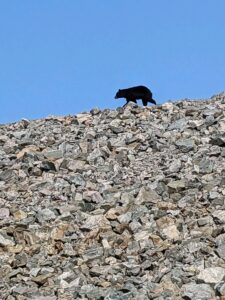 These days when the weather turns colder in winter, most Black Bears in New Jersey find a nice spot to curl up in a den (a hollow tree, caves, even in brush piles and downed log piles) and enter a state of dormancy called torpor, similar to hibernation. However, they could be awakened if disturbed. So, if you see a bear that appears to be “sleeping” – DO NOT APPROACH and just don’t disturb them! Also note that they can emerge from a den to take a mid-winter stroll on a bright, sunny day, looking for a snack or two. Black Bears have been seen walking about in EVERY month of the year in New Jersey.
These days when the weather turns colder in winter, most Black Bears in New Jersey find a nice spot to curl up in a den (a hollow tree, caves, even in brush piles and downed log piles) and enter a state of dormancy called torpor, similar to hibernation. However, they could be awakened if disturbed. So, if you see a bear that appears to be “sleeping” – DO NOT APPROACH and just don’t disturb them! Also note that they can emerge from a den to take a mid-winter stroll on a bright, sunny day, looking for a snack or two. Black Bears have been seen walking about in EVERY month of the year in New Jersey.
As per NJDEP-NJDFW: “Black bears by nature tend to be wary of people. If you encounter a black bear in your neighborhood or outdoors while hiking or camping, follow these common-sense safety tips”.
DON’T’S
- Do not feed bears.
- Do not approach bears. Especially feeding bears, which will aggressively defend their food.
- Do not run from bears. Running may trigger a chase response.
- Do not make direct eye contact. Bears may perceive this as a challenge.
DO’s
- Remain calm and slowly back away.
- Make the bear aware of you.
- Be loud: speak in an assertive voice, yell, sing, or clap your hands. If available, bang pots and pans or use an airhorn.
- Make yourself look big. Wave your arms. Hold your jacket above your head.
- If you’re in a group, stay together and perform these actions together.
- Make sure the bear has an escape route. If a bear enters your home, prop all the doors open.
- If the bear doesn’t leave, move to a secure area.
- Black bear attacks are extremely rare. If a black bear does attack, fight back! Aim for the snout and/or eyes. Use anything at hand: (knife, sticks, rocks, binoculars, backpack or kick the bear).
REMEMBER
- The bear may utter a series of huffs, make popping sounds by snapping its jaws and swat the ground. These are warning signs that you are too close. Slowly back away, avoid direct eye contact and do not run.
- If a bear stands on its hind legs or moves closer, it may be trying to get a better view or detect scents in the air. It is usually not a threatening behavior.
- Black bears will sometimes “bluff charge” when cornered, threatened, or attempting to steal food. Stand your ground, avoid direct eye contact, then slowly back away and do not run.
Things to look for while out on the trail for SIGNS of bear activity. This could in the form of a footprint, scat, flipped large rocks or logs, claw marks on trees and even on utility poles (they use utility poles to mark territory, sharpen claws and even as back scratchers! – see poles along Fox Farm Road)
Enjoy nature and I hope you find something interesting out there on the trail!
Merry Christmas, Happy Holidays and stay safe!
Ranger Rich
Merrill Creek Reservoir
34 Merrill Creek Road
Washington, NJ 07882
(908) 454-1213 (ph)
(908) 454-2747 (f)
*Play MCR's Tree Finder Game !
Along the trails at MCR there are 9 different individual trees that have FACES. More Info...

